A halfstock with flint style patch box. The gun is signed "J. P. Moore New York" . It is profusely engraved and stocked in premium European walnut. The bore is rifled with 8 grooves and is .045 cal. The breech is hooked and measures 1" across flats. The muzzle measures 5/16" across flats. Barrel length is 32 & 3/4". The over all rifle length is 49". The gun is fitted with a single set trigger and LOP is 13 & 3/8". The butt plate width is 1 & 1/8". The style of this rifle seems to be very "English" including the engraving. Note the detail on the hammer. Another feature to note is the absence of an under rib. The ram rod groove is milled right into the bottom flat of the barrel. The sights are typical fixed hunting sights (low to the barrel). I think this gun was made a high end sporting rifle circa: 1850- 1860. It remains in excellent condition.
----------------------------------------------------------------------------------------------------------------
Subsequent info: J. Maynard stamped in ramrod groove at breech.
----------------------------------------------------------------------------------------------------------------
Admin responded... "Probably a Remington blank finished by Maynard" and included the following:
[Strange as it may seem, one of the greatest 19th century American firearms innovators was a dentist who originally wanted to be a soldier. Edward Maynard, born in New York in 1813, dropped out of West Point due to ill health following his first year at the academy. Although he lived a long and presumably healthy life, Maynard never returned to the military. Instead, he rose to become one of the most prominent dentists in the United States, and counted the country's political elite, including congressmen and presidents, among his patients. Maynard's reputation as a Washington DC oral surgeon spread far afield, and it is reported that he was offered, but declined, a job as Imperial Dentist to Tsar Nicholas I.
Today, however, Edward Maynard's impressive career in dentistry is but a footnote to his role in the small arms field. Over the course of his life, Maynard was awarded 23 firearms related patents. He is best known for his first invention, a small arms priming system registered at the US Patent Office in 1845, which accelerated the rate of fire of a muzzle loading, percussion ignition gun by eliminating the need to place a percussion cap on the weapon's nipple for each shot.
Maynard's process involved a roll of caps, not unlike that used in today's cap guns, which were advanced from a magazine over the nipple as the gun was cocked. The invention as adopted by several commercial gun makers and, most notably, the United States government on its 1855 family of .58 caliber rifled arms. The Maynard priming system did not work as well in the field as expected, however, and was dropped in the 1861 version of the rifle-musket. Union Private Philip H. Smith, issued the Model 1861, believed it was a "far superior rifle altogether" to the Maynard primer equipped Model 1855. Smith thought "tape locks is played out, some likes them best but I can't see the edge. I have used them both and I know."
Maynard's rifle patent of 1851 would, in the end, prove far more long lasting than his priming system. His simple and effective single shot rifle was operated by a lever which, when depressed, opened the breech for loading by raising the barrel. After insertion of a cartridge, raising the lever closed the gun's breech. The loaded rifle was then cocked and primed by placing a cap on its nipple or simply cocked so that its Maynard priming system advanced a primer atop the nipple.
A significant feature of the new gun was its method of preventing gas escape at the breech, a prime concern of the externally primed breechloaders of the 1850s. The Maynard cartridge was brass, with a small hole in the center of its base so that the explosion of the cap could ignite it. The cartridge case also had a generous rim, which enabled its swift extraction by the shooter's fingers, and was reloadable as many as 100 times.
Springfield Armory manufactured a sample model Maynard carbine in .48 caliber, which was tested by US army Ordnance officers in May of 1856. The army fired Dr. Maynard's gun at ranges from 100 to 500 yards, and found it the best breechloader tested to date. Subsequently, the powder charge of the cartridge was raised from 30 to 40 grains of musket powder, loaded behind a 343 grain lubricated bullet.
In 1857, Maynard and some financial backers founded the Maynard Arms Company, and contracted with the Massachusetts Arms Company to manufacture breechloaders for sale to the general public, and, it was hoped, the military. Maynards were offered in .35 and .50 calibers, and could be had with interchangeable barrels to shoot shot cartridges. A second military test resulted in an army order for 400 .50 caliber carbines, with the original long-range aperture tang sight replaced with a barrel mounted open sight. The Revenue Cutter Service (Coast Guard) and Navy ordered smaller numbers of Maynards. The Maynard received rave reviews in frontier service, with Lieutenant Colonel B.S. Roberts of the U.S. Mounted Rifles commenting "…for light troops and skirmishers, the Maynard rifle is the most destructive war weapon that has ever been invented."
Despite the praise, few First Model Maynards saw Federal service. Arms historian John D. McAulay lists only four regiments partially armed with the gun between 1861 and 1863; the 1st (later 4th) US, 9th Pennsylvania and 1st Wisconsin Cavalry. Considering the pre-war enthusiasm for the Maynard, there is no doubt many more would have seen service. Unfortunately, the Massachusetts Arms Company factory burned down in January, 1861. The factory was rebuilt by 1863 and received an order for 20,000 of the simpler Second Model Maynard carbines that year. Deliveries of these guns began in June of 1864 and continued through May of 1865. Due to their late delivery, few of the Second Model Maynards actually saw service. Some did, however, in the hands of men of the 9th and 11th Indiana and 11th Tennessee Cavalry
More Maynards probably saw service with Confederate than Union forces. With war on the horizon, some Southern states purchased Maynards for their militia service in late 1860 and early 1861. Prescient southerners bought 90% of the 3,201 Maynards the factory saved from the fire. Most of these sales were to Florida, Georgia, and Mississippi. The First Model Maynard was considered an official Confederate firearm, and was carried in Confederate ordnance manuals as such.
With a well earned reputation for long range accuracy, the Maynard, especially the tang sighted version, was not limited to cavalry use in the Confederacy. Rebel sharpshooters made good use of the Maynard, especially during the siege of Charleston. On one occasion in 1862, a Georgian perched in a tree near Savannah reportedly used his Maynard to shoot a Federal officer at a range of 600 yards.
Although unable to produce internally primed rimfire cartridges to fuel captured Spencers and Henrys, Confederate ammunition makers were able to make the relatively simple Maynard round until late in 1864, when a shortage of raw materials hindered production.
Easily adaptable to the new primed metallic cartridges, the Maynard was one of the few patent breechloaders to survive the Civil War. It continued in production as a highly regarded centerfire target and hunting rifle until 1890.]
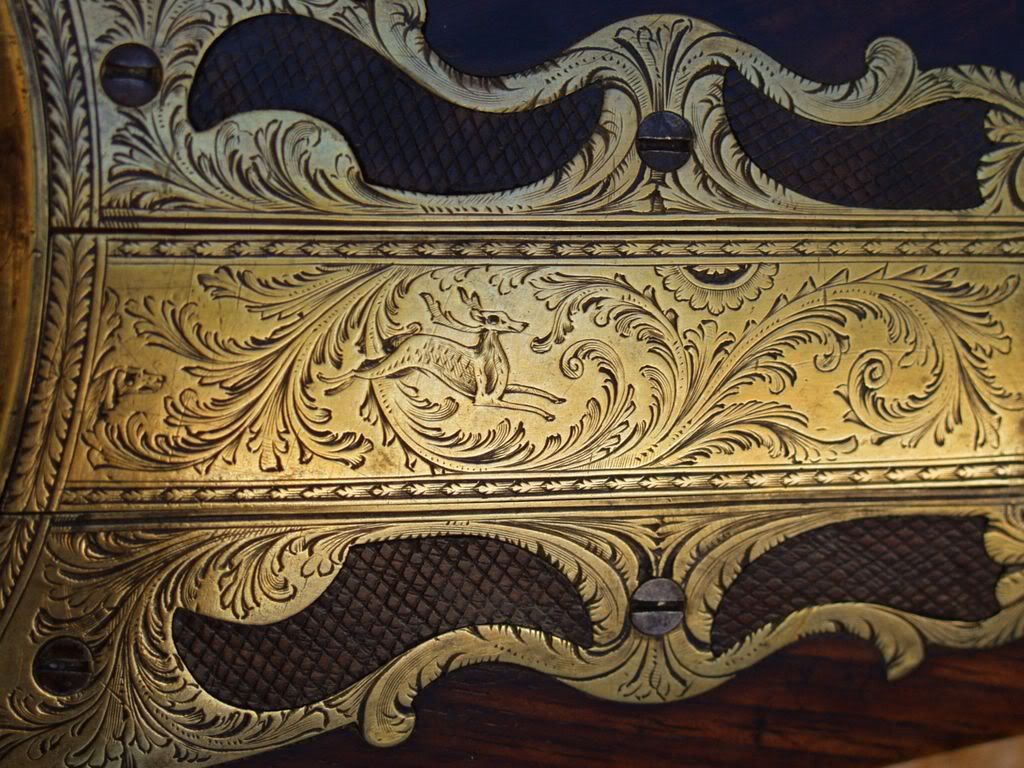
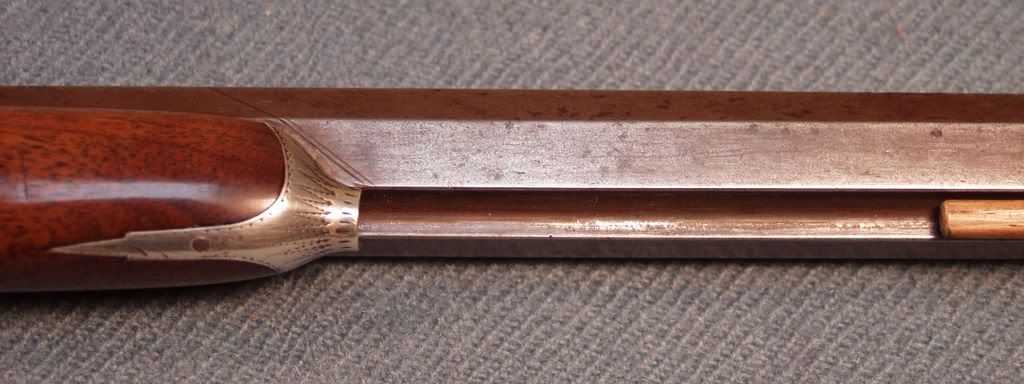
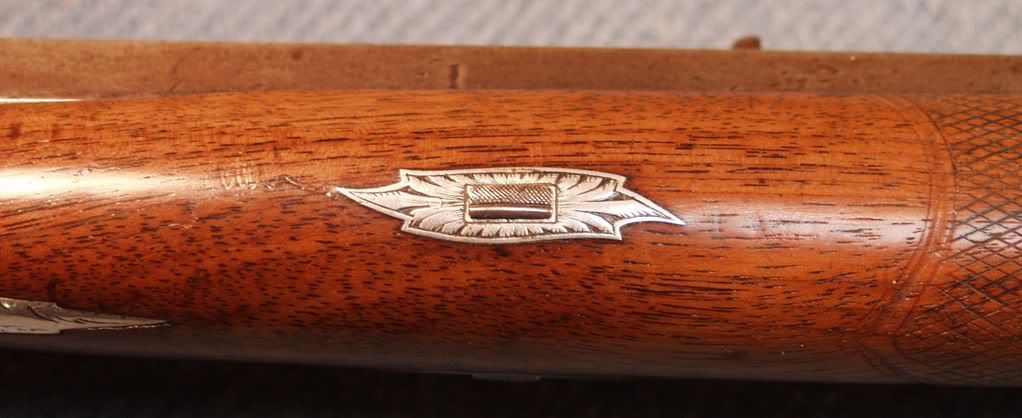
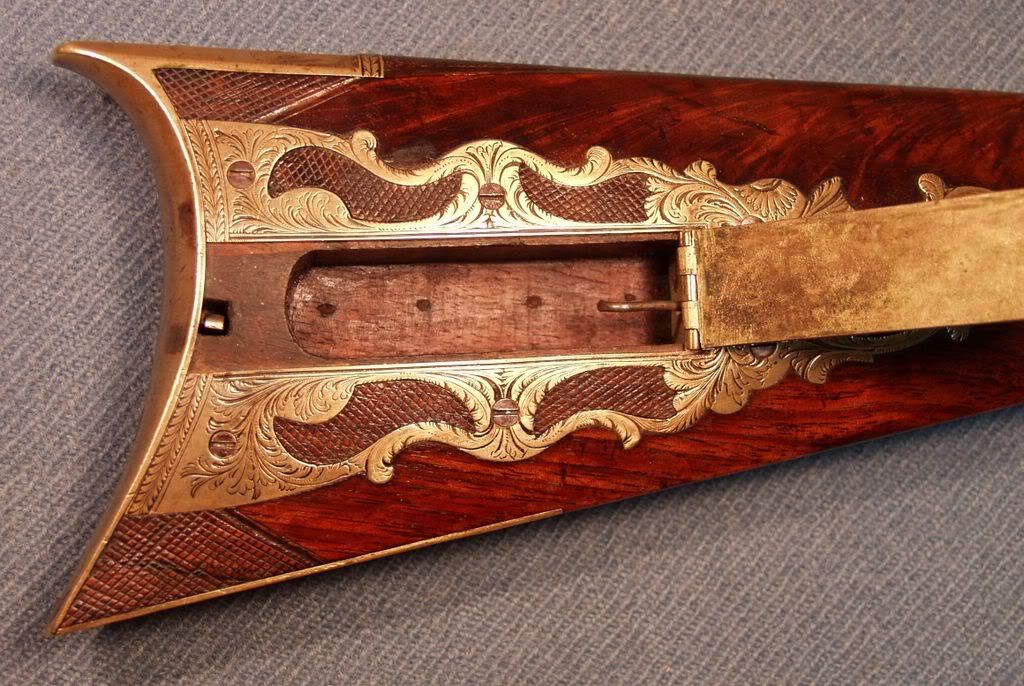

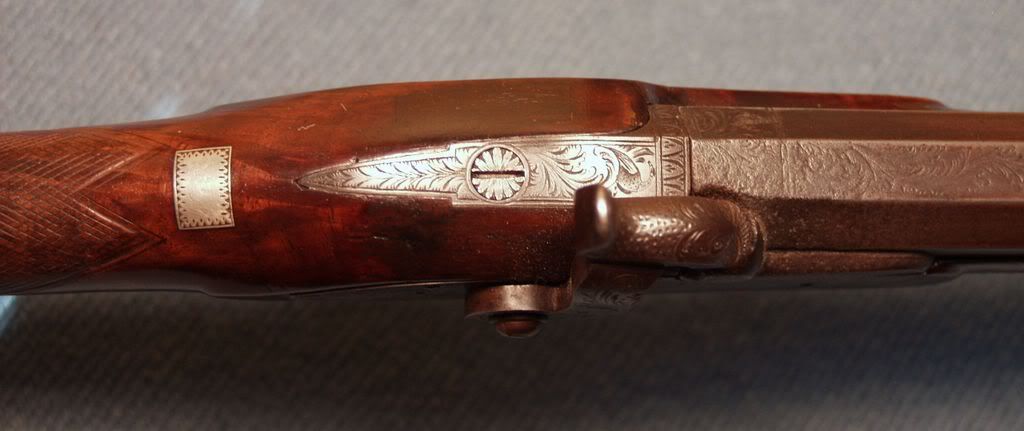
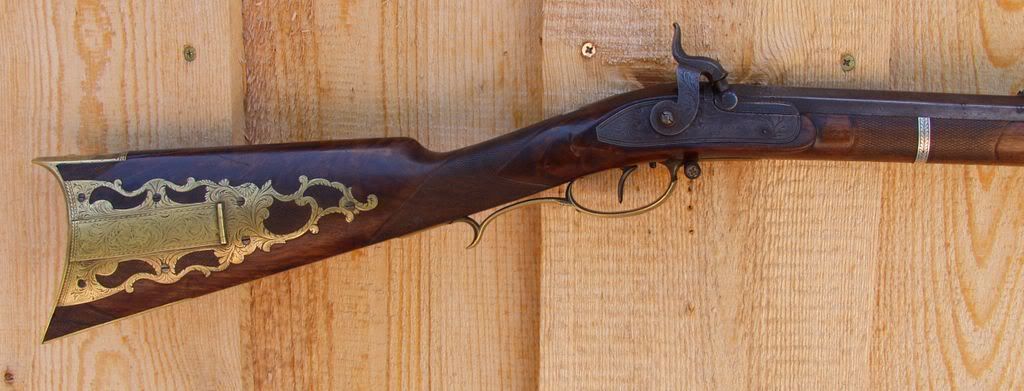
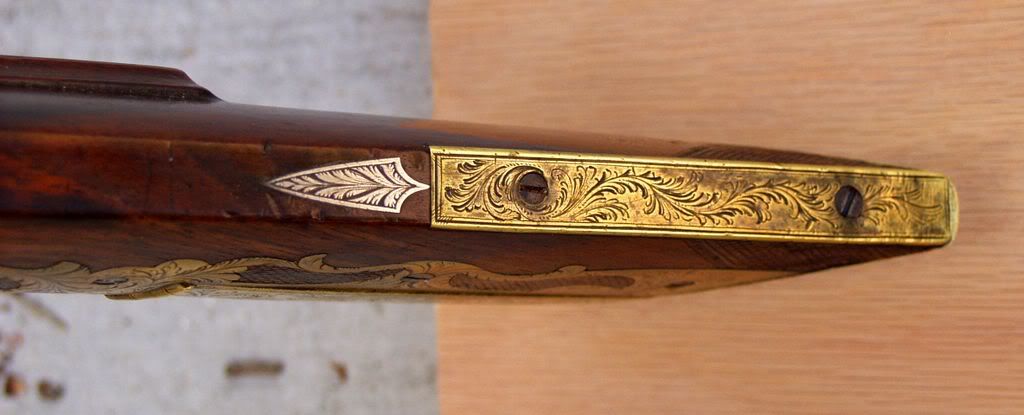
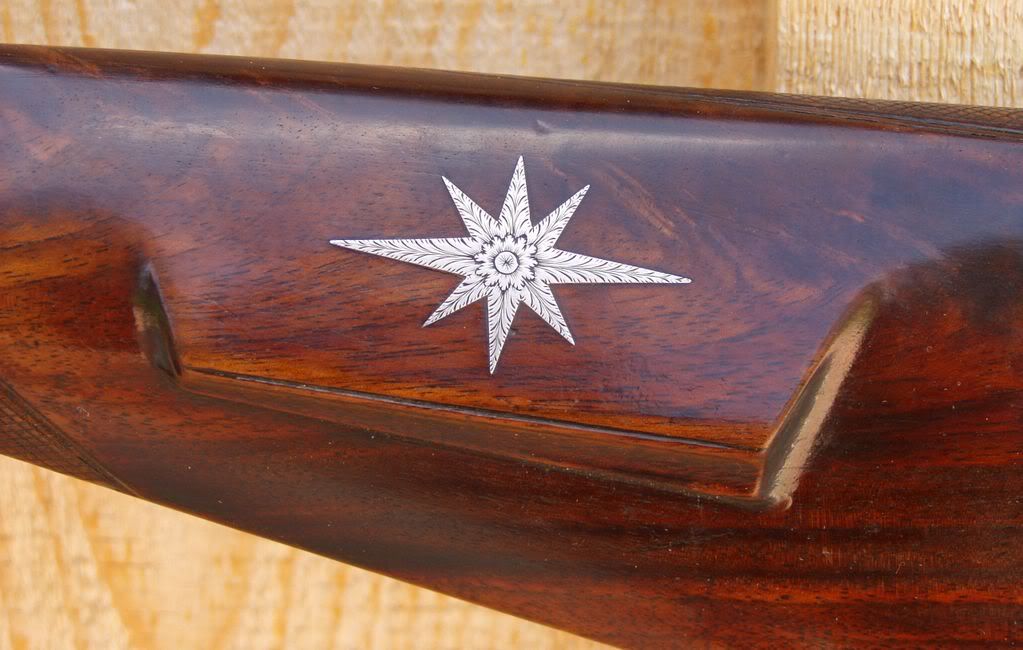

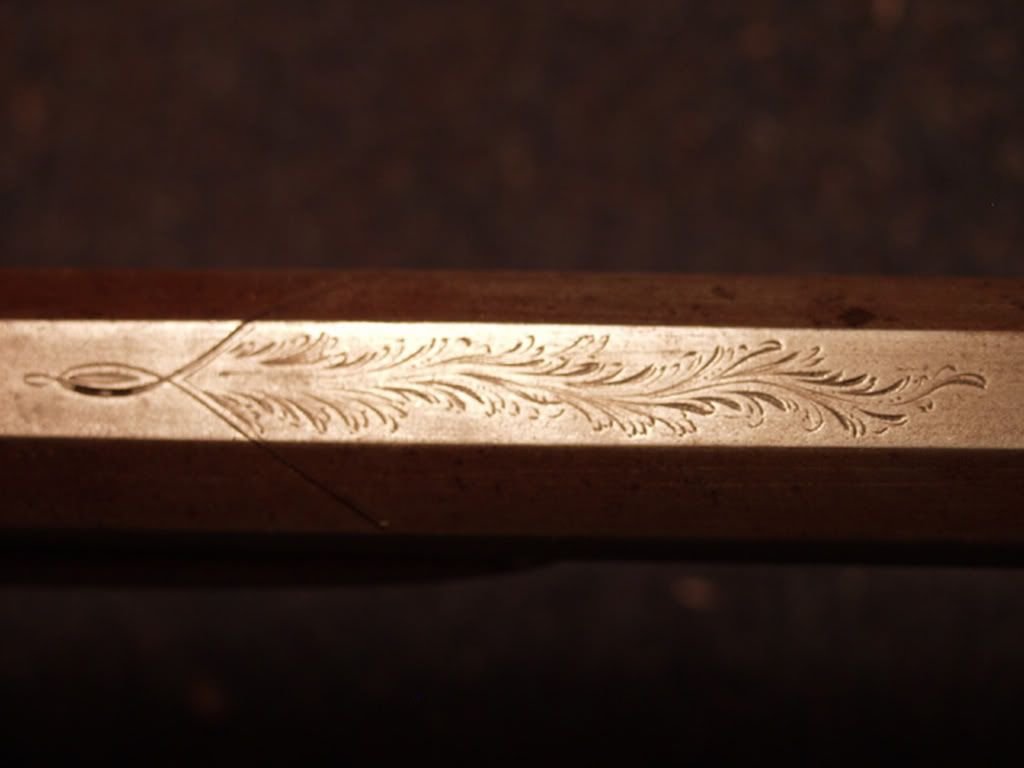
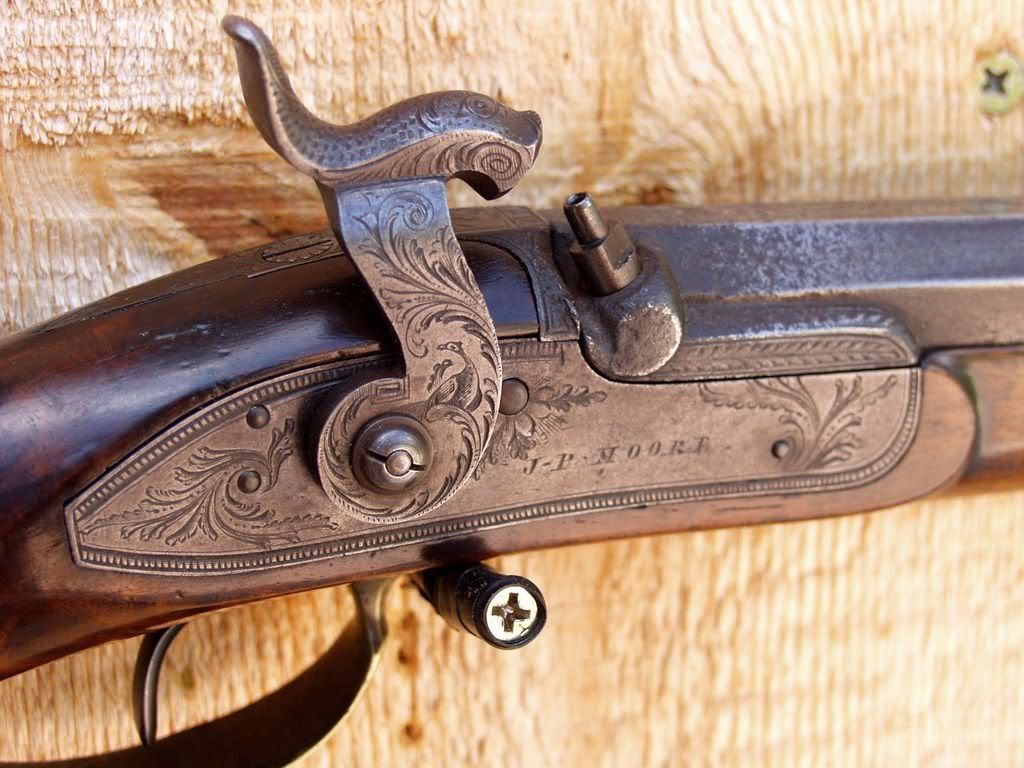
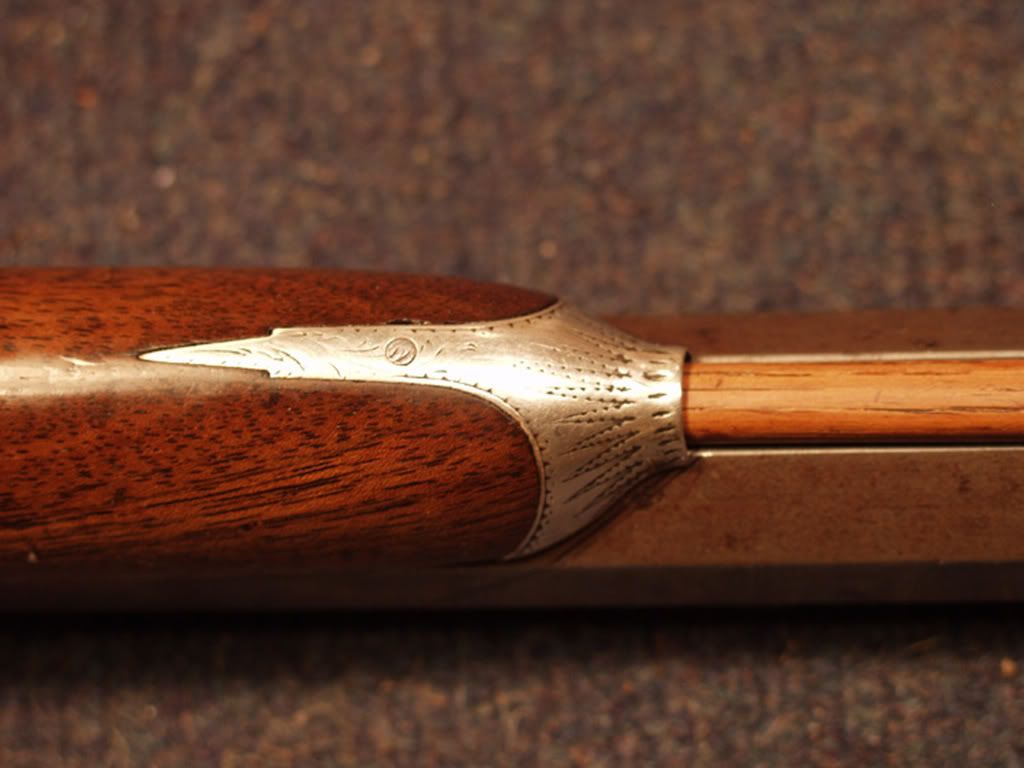

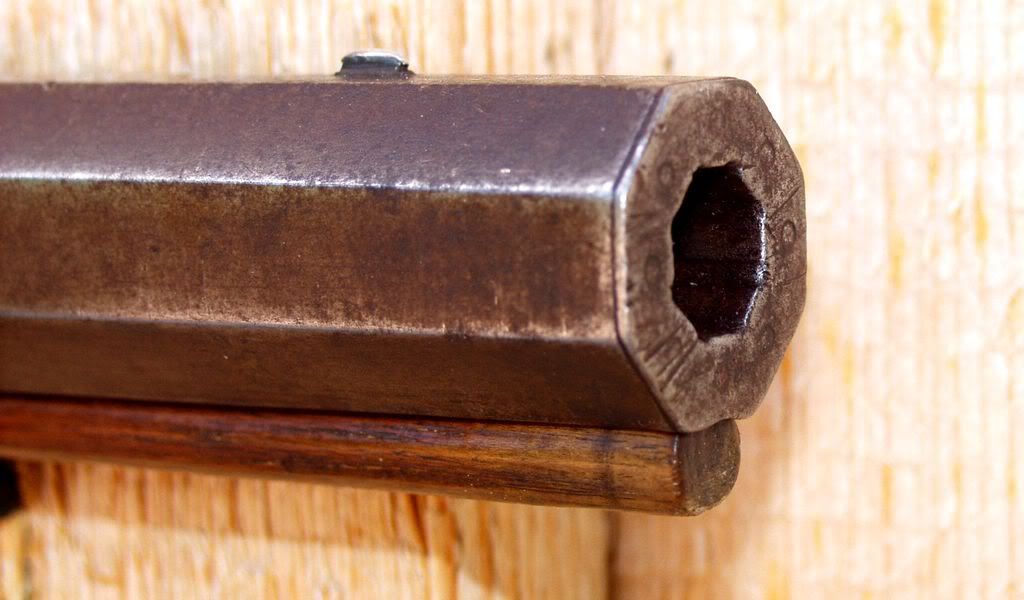
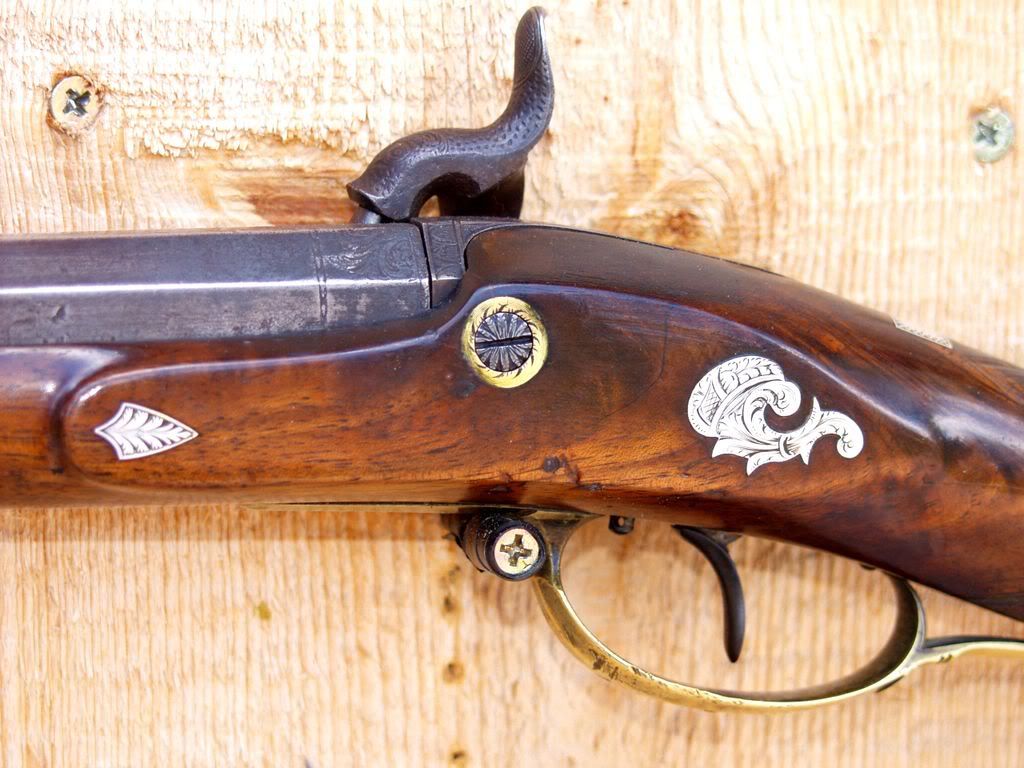
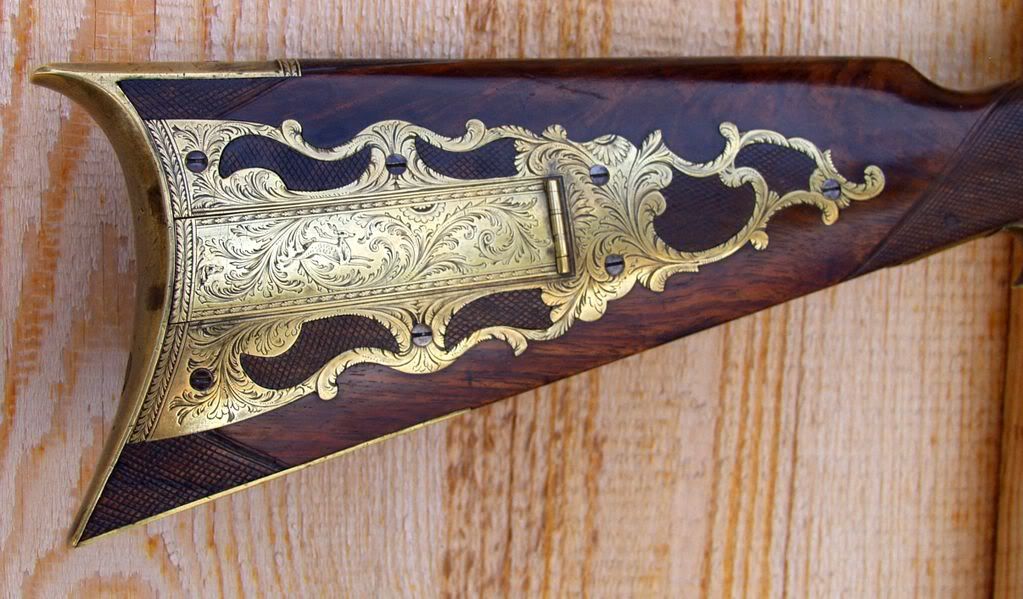
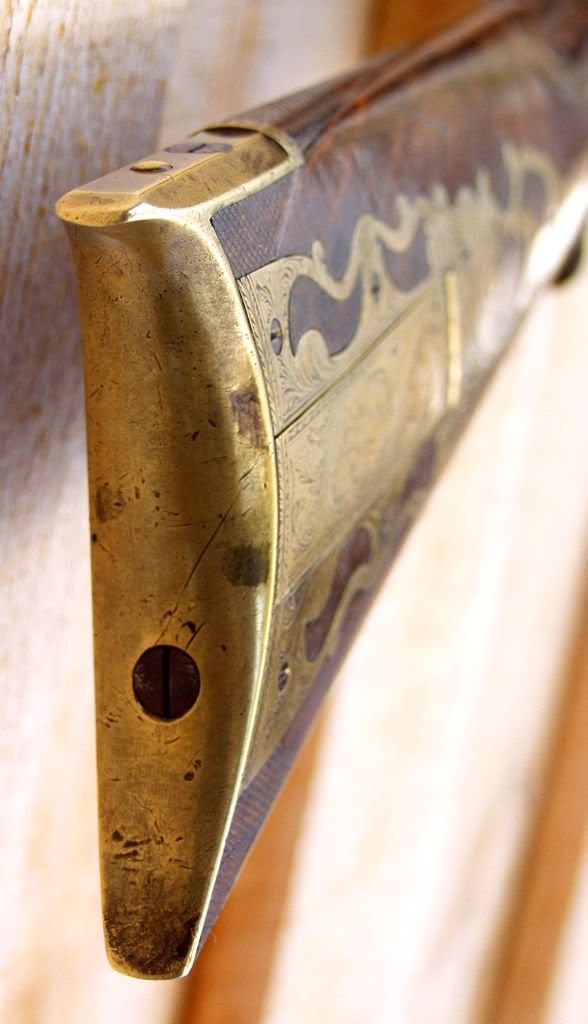
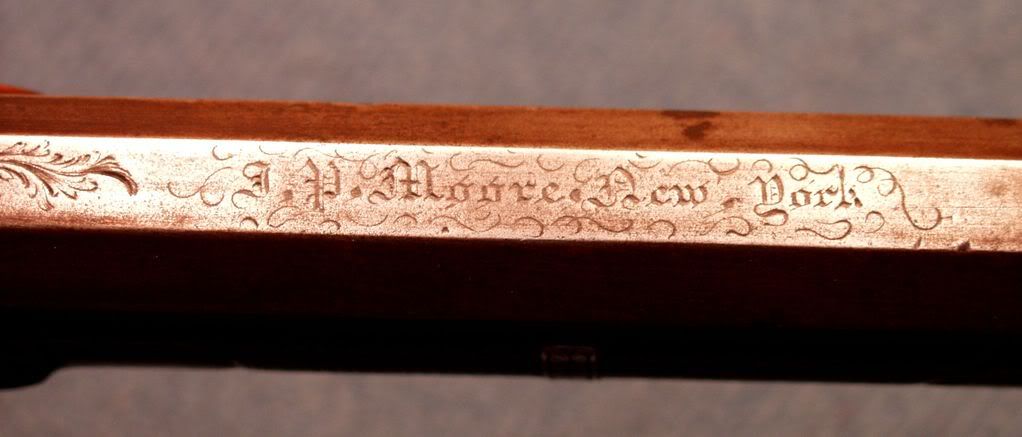
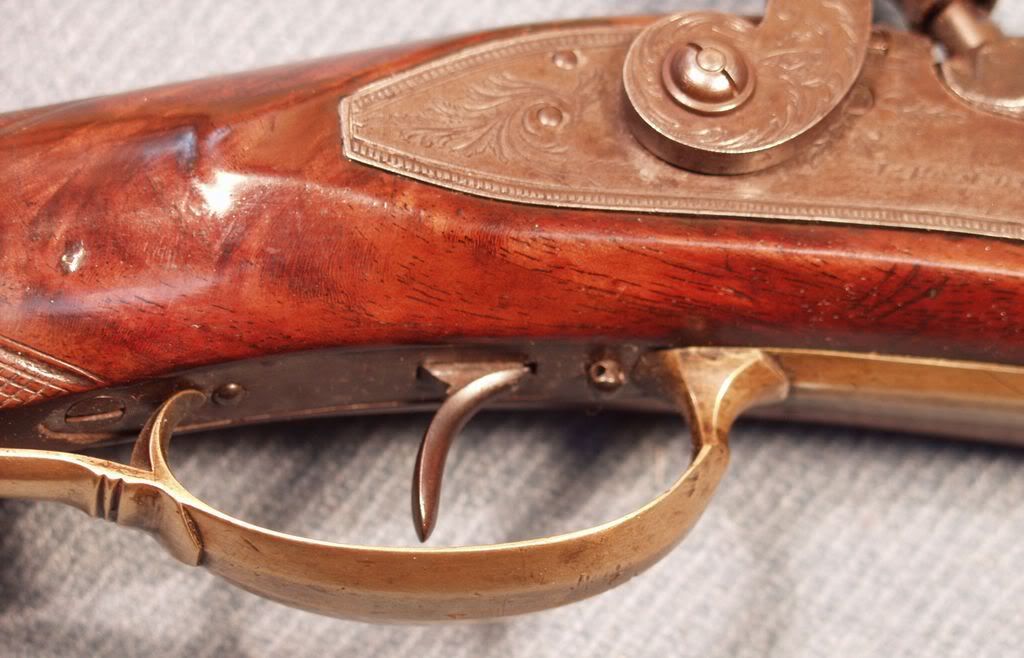
----------------------------------------------------------------------------------------------------------------
Comments:
J. P. Moore... Listed by Ned Roberts as made in Union, NY. "Union" could be a reference to NYC as in Union Square, but is more likely either Union in the Southern Tier or the village of Union (since dissolved) near Schenectady.
The general layout of the gun suggests Mohawk Valley. While walnut was being used locally at the time, I'm a bit suspicious that the gun is an import. Either finished by Moore and stamped with his name, or merely stamped after arriving in finished condition.
______________________________________________________________________
I seem to recall mention that Moore retailed guns out of NY. By this I assume NYC, but I'm unable to find the details as of yet and this comes only from dim memory.
______________________________________________________________________
Beautiful rifle. Typical New York patchbox style. Single set trigger and checkered wrist. Only thing that I question is the finish, which to me appears to be a refinish. This is due to a total lack of darkening along edges of furniture where oxides were rubbed into the nearby stock wood, and the high shine. The barrel looks like it has some wear at breech and muzzle, which in my opinion would lead to a slighlty less perfect wood finish. I don't recall seeing checkering inside the patchbox piercings before, and at toe. Makes me wonder if the toe got damaged and repaired, and the checkering was extended to hide the repair, or glue joint. But a beautiful, superior quality rifle.
______________________________________________________________________
This is an outstanding American rifle built in an English tradition, it appears. The maker spent a lot of time on the fine details and has lavished considerable artistry on the piece. The patchbox is comparable to Fleeger's work in concept and engraving and the overall effect of the maker's efforts is stunning.
----------------------------------------------------------------------------------------------------------------
This rifle was made in New York City. John P. Moore's shop was listed at various addresses in NYC from as early as 1820 through at least as late as 1850. The business became "J. P. Moore & Son" in 1859, and "J.P. Moore's Sons" by 1864. His sons continued the business until at least 1881. The Moore shop was at 204 Broadway from 1843 until May 1, 1874, when it was moved to 300 Broadway, where it remained through 1881. The way this rifle is marked seems to indicate that it was made prior to 1859. It is of superb quality. The New York State Firearms Trade, Vol. 5 shows a cased percussion target rifle marked "J. P. MOORE & SON" which is of comparable quality.

